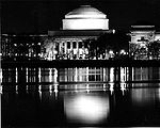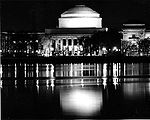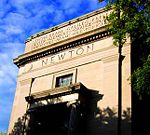
The Gadget Maker
Encyclopedia
The Gadget Maker is a 1955 novel by Maxwell Griffith. It is notable for its vivid depiction of an otherwise-rarely-described milieu: campus life at MIT
in the 1940s. It also presents a striking engineers-eye-view of guided missile
development at a West Coast aerospace firm during the early days of the cold war.
On its appearance, the New York Times described The Gadget Maker as "the story of a misguided zealot devoted body and soul to the advancement of knowledge" and called it "an absorbing narrative [and] a clear presentation of technological subject-matter, written with stylistic ease and fluidity by an author who is himself a graduate of the Massachusetts Institute of Technology."
After graduation, he joins Amcraft, the Amalgamated Aircraft Corporation, in Los Angeles
. It is a manufacturer of aircraft components that is just about to unveil its first complete airplane, a transport. The company is run personally by Dave Humbler, "president, founder of the company, chief engineer—big wheel number one. Real nice guy, Dave," a colleague explains. (Resemblances can be seen to the Douglas Aircraft Company
.) Brack rises through the ranks and grows with the company.
After the war Amcraft acquires the services of Gunther Rausch, "a spoil of war" and a rocket expert from Peenemünde
. His presence gives the company an edge in picking up missile work.
Rausch is brilliant but arrogant and Brack detests him. Nevertheless, as the book draws to a climax
, he makes common cause with him in an effort to perfect a guided missile. Brack is the project manager, and the project is in trouble and behind schedule. He pressures a friend and colleague into conducting some dangerous rocket tests with Rausch. Rausch is tense and jittery and gives coworkers an impression that he is concealing personal inexperience in conducting such tests. There is an explosion, and Brack's friend Sim suffers terrible injuries: physical and chemical burns and lung damage that leaves him close to death.
Brack's fiancée, a witness, tells Brack that Rausch was panicky during the test and "never stopped fiddling with the switches... he was like some hot-head whose car won't start but who keeps on turning the ignition switch." She thinks Rausch could have caused the explosion (a concern which ultimately turns out to be unfounded). Brack furiously argues with Rausch, then debates with his superior about the project's future and who should lead it. Brack convinces his superior to let him continue as leader. As the discussion closes, his superior says "Okay, it's all settled." But he adds "One other thing—I'm firing the girl." Brack's protest sticks in his throat; "ashamed, he looked at his feet, and then he nodded."
The book closes with Brack and Rausch standing together literally arm in arm, watching the conclusion of a successful missile test. "Did you see it, Gunther?" Brack says. "Yah," breaths Rausch, "Just like a star. A shooting star." "And we made it," says Brack, proudly, as the tale ends.
The New York Times reviewer says that "the question arises... whether Brack is to be regarded as an all-wool idealist pursuing heroically his destiny despite any and all distractions tossed in his way. Or is he a less desirable type, possessed of the ability to abandon all pretense to ethical conduct in his ambitious pursuit after self-advancement?"
Although the Times calls it an "absorbing narrative," to a modern reader much of the interest lies, not in the broad story outline, but in the dozens of little details and circumstantial touches which bring times, places, and situations—not well documented elsewhere—to life.
Massachusetts Institute of Technology
The Massachusetts Institute of Technology is a private research university located in Cambridge, Massachusetts. MIT has five schools and one college, containing a total of 32 academic departments, with a strong emphasis on scientific and technological education and research.Founded in 1861 in...
in the 1940s. It also presents a striking engineers-eye-view of guided missile
Guided Missile
Guided Missile is a London based independent record label set up by Paul Kearney in 1994.Guided Missile has always focused on 'the underground', preferring to put out a steady flow of releases and developing the numerous GM events around London and beyond....
development at a West Coast aerospace firm during the early days of the cold war.
On its appearance, the New York Times described The Gadget Maker as "the story of a misguided zealot devoted body and soul to the advancement of knowledge" and called it "an absorbing narrative [and] a clear presentation of technological subject-matter, written with stylistic ease and fluidity by an author who is himself a graduate of the Massachusetts Institute of Technology."
Synopsis
The novel traces the life of Stanley Brack, captivated by model aircraft as a child. He enters MIT, and in a memorable scene, is interviewed by the head of the School of Aeronautical Engineering, a legendary German aerodynamicist. His main concern is unexpected. "From your hair and general coloring," he said slowly, "I thought you might perhaps be Jewish." Brack reassures him that he and both his parents are Baptists and of Scots-Irish descent. "We have to be careful," the professor confides; "The aircraft industry is one of the few they haven't managed to take over yet," and congratulates Stanley on his acceptance into the course. The incident turns out to be one of many in which Brack swallows any thought of protest and goes along to get along.After graduation, he joins Amcraft, the Amalgamated Aircraft Corporation, in Los Angeles
Los Ángeles
Los Ángeles is the capital of the province of Biobío, in the commune of the same name, in Region VIII , in the center-south of Chile. It is located between the Laja and Biobío rivers. The population is 123,445 inhabitants...
. It is a manufacturer of aircraft components that is just about to unveil its first complete airplane, a transport. The company is run personally by Dave Humbler, "president, founder of the company, chief engineer—big wheel number one. Real nice guy, Dave," a colleague explains. (Resemblances can be seen to the Douglas Aircraft Company
Douglas Aircraft Company
The Douglas Aircraft Company was an American aerospace manufacturer, based in Long Beach, California. It was founded in 1921 by Donald Wills Douglas, Sr. and later merged with McDonnell Aircraft in 1967 to form McDonnell Douglas...
.) Brack rises through the ranks and grows with the company.
After the war Amcraft acquires the services of Gunther Rausch, "a spoil of war" and a rocket expert from Peenemünde
Peenemünde
The Peenemünde Army Research Center was founded in 1937 as one of five military proving grounds under the Army Weapons Office ....
. His presence gives the company an edge in picking up missile work.
Rausch is brilliant but arrogant and Brack detests him. Nevertheless, as the book draws to a climax
Climax (narrative)
The Climax is the point in the story where the main character's point of view changes, or the most exciting/action filled part of the story. It also known has the main turning point in the story...
, he makes common cause with him in an effort to perfect a guided missile. Brack is the project manager, and the project is in trouble and behind schedule. He pressures a friend and colleague into conducting some dangerous rocket tests with Rausch. Rausch is tense and jittery and gives coworkers an impression that he is concealing personal inexperience in conducting such tests. There is an explosion, and Brack's friend Sim suffers terrible injuries: physical and chemical burns and lung damage that leaves him close to death.
Brack's fiancée, a witness, tells Brack that Rausch was panicky during the test and "never stopped fiddling with the switches... he was like some hot-head whose car won't start but who keeps on turning the ignition switch." She thinks Rausch could have caused the explosion (a concern which ultimately turns out to be unfounded). Brack furiously argues with Rausch, then debates with his superior about the project's future and who should lead it. Brack convinces his superior to let him continue as leader. As the discussion closes, his superior says "Okay, it's all settled." But he adds "One other thing—I'm firing the girl." Brack's protest sticks in his throat; "ashamed, he looked at his feet, and then he nodded."
The book closes with Brack and Rausch standing together literally arm in arm, watching the conclusion of a successful missile test. "Did you see it, Gunther?" Brack says. "Yah," breaths Rausch, "Just like a star. A shooting star." "And we made it," says Brack, proudly, as the tale ends.
The New York Times reviewer says that "the question arises... whether Brack is to be regarded as an all-wool idealist pursuing heroically his destiny despite any and all distractions tossed in his way. Or is he a less desirable type, possessed of the ability to abandon all pretense to ethical conduct in his ambitious pursuit after self-advancement?"
Although the Times calls it an "absorbing narrative," to a modern reader much of the interest lies, not in the broad story outline, but in the dozens of little details and circumstantial touches which bring times, places, and situations—not well documented elsewhere—to life.
Quotations
- At night, floodlights glare from artfully concealing shrubbery and lave the main building with a white light that emphasizes black-trimmed, three-story windows rising in uninterrupted, eye-leading verticals toward a dominant, austere dome mimicked from some classic pile of ancient RomeRomeRome is the capital of Italy and the country's largest and most populated city and comune, with over 2.7 million residents in . The city is located in the central-western portion of the Italian Peninsula, on the Tiber River within the Lazio region of Italy.Rome's history spans two and a half...
. On every slab-sided cornice, like proclamations of faith needing no explanation, are chiseled Darwin
On every slab-sided cornice, like proclamations of faith needing no explanation, are chiseled Darwin Charles DarwinCharles Robert Darwin FRS was an English naturalist. He established that all species of life have descended over time from common ancestry, and proposed the scientific theory that this branching pattern of evolution resulted from a process that he called natural selection.He published his theory...
Charles DarwinCharles Robert Darwin FRS was an English naturalist. He established that all species of life have descended over time from common ancestry, and proposed the scientific theory that this branching pattern of evolution resulted from a process that he called natural selection.He published his theory...
, NewtonIsaac NewtonSir Isaac Newton PRS was an English physicist, mathematician, astronomer, natural philosopher, alchemist, and theologian, who has been "considered by many to be the greatest and most influential scientist who ever lived."...
, AristotleAristotleAristotle was a Greek philosopher and polymath, a student of Plato and teacher of Alexander the Great. His writings cover many subjects, including physics, metaphysics, poetry, theater, music, logic, rhetoric, linguistics, politics, government, ethics, biology, and zoology...
and, in lesser letters, the names of the more numerous LavoisierAntoine LavoisierAntoine-Laurent de Lavoisier , the "father of modern chemistry", was a French nobleman prominent in the histories of chemistry and biology...
s and EulerLeonhard EulerLeonhard Euler was a pioneering Swiss mathematician and physicist. He made important discoveries in fields as diverse as infinitesimal calculus and graph theory. He also introduced much of the modern mathematical terminology and notation, particularly for mathematical analysis, such as the notion...
s and FaradayMichael FaradayMichael Faraday, FRS was an English chemist and physicist who contributed to the fields of electromagnetism and electrochemistry....
s who have discovered the chemical elementChemical elementA chemical element is a pure chemical substance consisting of one type of atom distinguished by its atomic number, which is the number of protons in its nucleus. Familiar examples of elements include carbon, oxygen, aluminum, iron, copper, gold, mercury, and lead.As of November 2011, 118 elements...
s or evolved the equations or stumbled upon the fundamentals of nature. Indeed, not unlovely is the breeding ground of technicians and engineers which, as announced in stone above great, fluted columns, is the MASSACHVSETTS INSTITVTE OF TECHNOLOGY.
- "What do you expect from me—miracles!" Rausch demanded angrily. "Do you expect me to build an engine—" he snapped his fingers—"like so? I am a scientist, not a magician! To develop a new engine you must haf an organization that can supply the test benches with one experimental engine after the other. You must make, break and remake engines until you get one that works."

